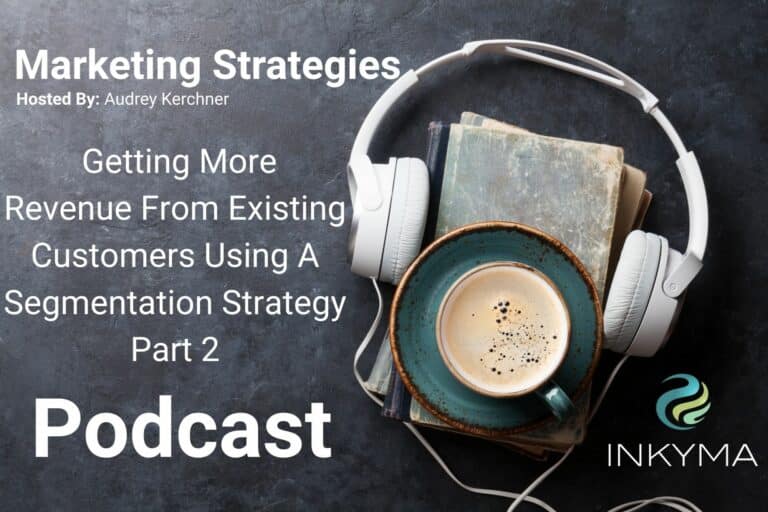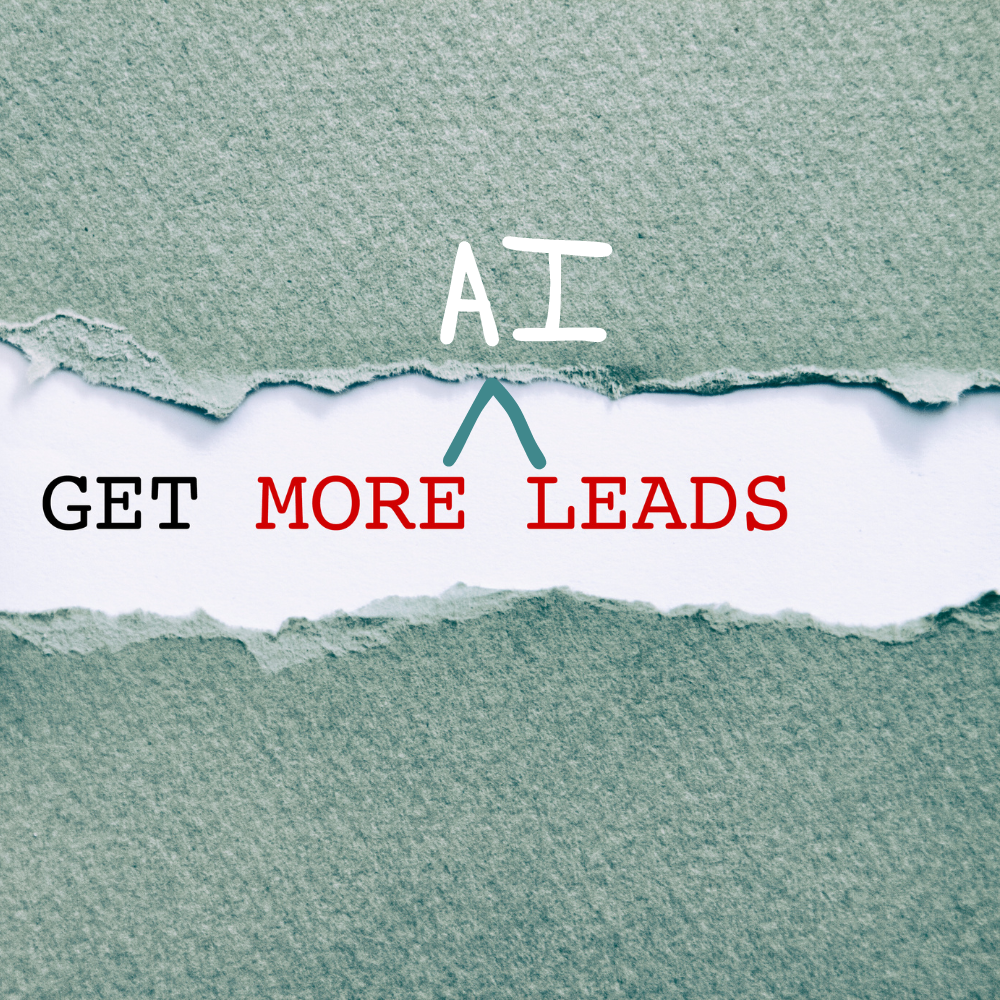What’s up, business owners! This is Getting More Revenue From Existing Customers Using A Segmentation Strategy (Part 2). If you haven’t listened to part 1, go back, listen, and take action. In part two, we divided into categorizations and give you a general idea of which ones work best for which types of companies and where to really apply pressure.
Links Mentioned In This Episode:
Getting More Revenue From Existing Customers Using A Segmentation Strategy (Part 2) Transcription
Audrey Kerchner:
This is part two of a two-part series where we’re talking about segmenting your existing customers to get more revenue from people who already buy from you. If you haven’t listened to part one, go back and listen. I strongly recommend that and building off of all the things I talked about in part one. And in part one, I talked about the different types of segmentation you can do with your existing audience and how you can profit from those segmentations. I shared a really great example of how growth occurs with existing customers and also an example of how you could actually lose money by not talking to your existing customers. And you’re actually throwing them into the arms of your competitors, which you absolutely don’t want to do.
Audrey Kerchner:
If you did listen and you want to sell more to your existing customers, you have to decide what your goals and your objectives are going to be before you put together your strategy. And then from your strategy comes your campaigns and your tactics. And that’s what we’re going to talk about today is which segmentation strategy you should use and then what campaigns and tactics are going to work beautifully with this.
Announcer:
Welcome to Marketing Strategies with Audrey Kerchner sponsored by Inkyma. Taking your small business to the next level with proven creative solutions designed to grow your awareness and connect to your customers. Now, here’s Audrey.
Audrey Kerchner:
I’m Audrey Kerchner, Co-founder and Chief Marketing Strategist here at Inkyma. Inkyma is what’s called a full-service marketing agency. We bring that big agency process, feel and service to small business owners, and we can help you with whatever marketing that your company needs. To learn more about what we do, ask a question or to schedule a marketing evaluation for your business, go to our website inkyma.com. That’s I-N-K-Y-M-A.com.
Audrey Kerchner:
Hopefully, you did listen to part one, but if this is your first ever episode with us, welcome. We really appreciate your listening. We have a lot of episodes out there. So if you want to listen to more about branding, about digital marketing, about a bunch of different stuff, you can find our podcast on any podcast platform out there, just put Inkyma in and Marketing Strategies will pop right up.
Audrey Kerchner:
You can also go to our website, we have all episodes there and we’re in the process of getting all of them transcribed so that you can actually read through some of the content that you’re listening to at the same time. And we’re on YouTube as well in case that’s where you like to listen to your content. In Episode 30, which was part one of this two-part series, we divided your audience into a bunch of different segment options. So now I want to go through those again just as a refresher. And then I also want to give you the different types of businesses that just easily dovetail into each of these different types of segmentation strategies.
Audrey Kerchner:
Any segmentation strategy, if you work hard enough is going to work for any business. And there may be even more out there that we’re not even talking about today. But what I want to do is kind of get your creative juices flowing to figure out where your business is going to sit if you haven’t completely decided on how you want to segment. Sometimes that kind of creates that, “Oh, well, if I do it this way, I can’t go and do it that way.”
Audrey Kerchner:
So let’s break these down just a little bit more before we go into the conversation about campaigns and tactics. So the first one I talked about last time was buying habits. And where we started was for high, medium, and low-value clients based on either frequency like how often they buy or purchase dollar amount, how much they’ve bought either in one purchase or over time. You can combine these two together so you can do frequency with the amount of purchase or they can be separate only frequency, only dollar amount purchased.
Audrey Kerchner:
And your objectives here are to kind of move them up that ladder. Go from low to medium, medium to high, and then either that or keep maintaining everybody at their current level so that they don’t go away. So the types of business, the categories of business that this lends itself to just really easily are e-commerce business online if you’re selling. Your systems you already know by customer, how much they’re spending when they’ve spent, how they found you, all that good stuff. Retail stores too, brick and mortars and then the combination of the two. If you have a retail store and an e-commerce, this works great.
Audrey Kerchner:
Service-based businesses that have reoccurring services also do really well with this. And of those service-based businesses, if they offer more than one type of service, this is a really great tactic for that too. So let’s talk about a couple of non-traditional types of services that this would work really well for, dog grooming. Dog grooming, you have a dog, it needs to be cleaned. And the frequency at which they get cleaned is really relative to the business owner. Some people do it once a year, the rest of the time they do it at home. Others, they get it done every other week. And then the number of things they do during the grooming. Is it just a basic shampoo? Are they getting their nails cut? Do they need to be dematted? Do they need to be shaved down?
Audrey Kerchner:
Those are all different variables that you can put into a CRM system or your buying system to then segment and categorize your clients. Low would be they bring them in once a year after the winter season or before summer to get shaved down, trying to get them to that medium level. Getting your mediums, maybe they come in once a month, come in more frequently or get the nails trimmed at least every other visit.
Audrey Kerchner:
And then your high-value customers, they bring them in monthly, they get the dematting, they get the extra shampooing, they get the nails done, offering them discounts on what they already get or to upsell them to something else to keep them at that high level is a really great way to implement this type of segmentation strategy. And then I’ve talked about this in other episodes, but auto care, the oil changes. Making them aware of your other services. Most places don’t just do oil changes. They do a tire rotation. They do a fall/winter checkup, topping off fluid levels. And again, high, medium, low.
Audrey Kerchner:
How frequently are they coming in for their oil changes? Are they coming in when they’re supposed to, trying to get everybody to come in on a schedule for spring, midsummer, and fall so that they all climb up that ladder? Those are really two great areas that probably don’t get enough attention when it comes to buying habits of your existing clients.
Audrey Kerchner:
The second type of buying habit that I talked about was making the buckets a little bit easier to put people in if you’re not ready to segment on frequency and purchases over time. Maybe you don’t have enough data for something like that. You’re a newer business or you haven’t been collecting the data and you started now, but you need a different place to jump off from. This is where a first-time customer, recent customer segmentation, repeat customer, a lapsed customer, or someone who buys something specific from you becomes a different category so you can sell them something different. Those are a lot easier to categorize. You can just look at them and know.
Audrey Kerchner:
And so an example of a business here, same as the first one, but like with the auto care company, you can sell a package for reoccurring services like oil changes to first-time customers. You can say, “Hey, thanks for being a first-time customer. Did you know that we offered this great package for you to get your oil changes done on a frequent basis? And we throw in free this and free that because you’re a member of our oil change club.” However you want to put it together and name it, but letting them know right away will get them to onboard a lot faster. Don’t let them figure it out two or three oil changes later when you could’ve gotten them in sooner.
Audrey Kerchner:
Now let’s move on to geographical events. As a reminder, geographical events I’ve categorized as trade shows, having a booth at any given event, weather-related events in a town or a city. So like spring storm season and hurricane season, anything where there’s flooding. Other types of seasonal campaigns, but are hyperlocal to a specific region. So maybe you have a fair or an event that’s huge for your region. I talked about pioneer days. I talked about the Shad Festival.
Audrey Kerchner:
Another one I’m going to throw in there for my Chincoteague Islander friends is pony penning. So if you don’t want to know what any of those are, go look them up. They’re a whole lot of fun, but they are hyperlocal to an area and not necessarily a national event like Christmas or New Year or a Labor Day. Now the types of companies that benefit from being aware of and marketing for these are all your trade guys. Your general contractors, your electricians, your plumbers, your disaster recovery folks, anybody in the trades. Event-based companies like venues, photographers, caterers, hairstylists, and insurance agents, they can all capitalize from this.
Audrey Kerchner:
So I’m going to give you a couple of examples here. Let’s talk about a hairstylist. They have repeat customers. People find a stylist and they love them and they go back to them when they need them, but you can still get more revenue from them just from generating more awareness. Let’s talk about prom season. So you can segment your audience by a specific age range and maybe even their zip code. Because if you service a large area, there might be two or three high schools in your area. Then you can send out an email or a postcard that’s saying, “Hey, prom season’s coming. We have this great package for your hair, your makeup, and your nails. Schedule your appointment now, otherwise, we’re going to be completely booked if you wait too long.”
Audrey Kerchner:
So that’s a great campaign. Another one is a photographer. Some photographers are very savvy and they understand the lifetime value of a client, especially if they do all sorts of photography. They can get a couple at their engagement pictures, then they can do the wedding picture. And that’s a package, but then they can also come back to them and sell up to them like when they have their first child, the newborn pictures, the first birthday pictures, the family photos year after year.
Audrey Kerchner:
So the lifetime value to a photographer constantly creating awareness with a single couple is like 17 to 20 years or more depending on how many kids they have. And so that’s why they should constantly be letting folks know, “Hey, we have this” and do reminders. “It’s your annual family photo reminder, let’s book a date now and our location for you to do your fall pictures.” Constantly put that out there and remind them.
Audrey Kerchner:
And then the last segmentation is the email activity, interacting with your newsletter, your sales funnel, a one-time event reminder. They answered the phone. You have to track that stuff too. They responded to a text message. Any type of interaction is valuable. You can track the opens of the email. The types of businesses that do really well with these types of things that may not do well with other stuff are service-based businesses specifically health professionals, accountants, insurance companies, and other service businesses.
Audrey Kerchner:
So let’s talk about healthcare professionals. Let’s say we have a general practitioner’s office. Obviously, people go to them year after year. You can segment your audience by who got flu shots last fall and then send out reminders at the beginning of the next flu season that it’s time for them to get their flu shot. And Oh, by the way, you got a great giveaway, a T-shirt a bag. I’ve seen other doctor’s offices do this where they’ll give someone for coming in and doing a health checkup type of service. They’re trying to promote health, not just service them when they’re sick. And by sending those reminders out, you’re going to get better compliance. People are going to schedule it and then you can also talk about the ease of scheduling it with them in the office. It’s much more private versus going to the local pharmacy where maybe sitting in a waiting area where people are going back and forth.
Audrey Kerchner:
Some people don’t like that. So make sure you’re including all of that information. You can get really creative with this. Like I said, at the beginning, anybody can use any of these categories. I was just giving you the top ones to use for each type of business, the product-based business, the service businesses, the service businesses with reoccurring services, but you could really just categorize them in any different way. And hopefully, this has given you a better understanding of the segmentation strategy that you want to use for your business.
Audrey Kerchner:
You’re listening to Marketing Strategies and I’m Audrey Kerchner. And we’re talking about leveraging your existing customers to grow your business. If you have a marketing question or a topic that you want to hear more about, then submit a form on our website at inkyma.com. That’s I-N-K-Y-M-A.com and on the bottom of pretty much every single page we have there, there’s a contact form. Just put your information in and I will absolutely get back to you regardless of if it’s a question or anything.
Audrey Kerchner:
Okay, so you got your segment down. Let’s talk about campaign ideas. You’ve segmented them, you figured out what your goals and objectives are, but then what do you send them? What do you do with them? So let’s talk more about that. I’m going to focus on email marketing. There’s a ton of different things that you can do. You can do calling campaigns. I don’t recommend that. Everybody is so, so tired of getting robocalls. They’re even skeptical about when someone that they do business with frequently calls them. They’re afraid that it’s not them, or it’s not legitimate.
Audrey Kerchner:
Texting campaigns. You could do social campaigns. You could do digital ads. I don’t recommend those. With social, you can’t direct those posts. You can’t say only show this post to these people. It’s going to get sent out. It’s going to be a mix. You’re never going to know exactly who saw it. And if you’re trying to hit existing customers, it’s not going to be as effective. It’s going to get watered down because with social when you put a post out, it usually, at most, goes to a one to 2% of your audience. Wherewith an email campaign, if you say only send it to these 50 people, it’s only going to those 50 people and it got to those 50 people. And then you’ll know exactly how many people opened that email and what they did with it. Far, far more beneficial than social posting.
Audrey Kerchner:
And then I don’t recommend doing digital ads to your existing audience for segmentation purposes. It’s too expensive. You’ve already paid the money to get them into your database in some form or fashion. They’ve already purchased from you. Talking through email, or maybe even doing postcard mailings is a much more intimate way to reach out to them with these offers than with digital ads, because they’re assuming digital ads are just sent to them and it’s a fluke that they actually saw it. So don’t waste your money.
Audrey Kerchner:
And now we’re just going to talk about how you execute these campaigns from an email perspective. Back to buying habits. If you remember, high, medium, and low-value clients based on frequency or dollar amount purchased and what you’re trying to do is move them up the ladder from low to medium to high, and getting the folks that are high to stay there. So what we want to implement here, just as an example is email automation and we’re going to do it based off of spend and frequency. And what you’re going to send them is an email that’s been automated based on those trigger criteria that gives them a coupon for a similar service.
Audrey Kerchner:
So here’s what that looks like. You have an example customer and they reached $300 in product spend, and that designates them as a medium value customer. And so for your medium value customers, you’re saying, “Okay, I’m going to give them somewhere between 10 and $25 off. If they make their next purchase over $100 or more.” And that’s what you put in the email. We’re so grateful that you’re a customer. We know you’ve been spending X, Y, and Z on these things. “Here is a $25 coupon off of your next order of $100 or more. Please use this within the next month or so.”
Audrey Kerchner:
Now the ones that do take advantage of that, depending on your categorization, but in this example, we’re going to assume that that $100 or more automatically pops them up into high value. So you’re seeing movements through your segmentation right away with just one email campaign. And you can decide to do reminders to that. “Hey, we sent you this special offer. It’s about to expire. We don’t want you to miss it. Use it today.” And you can send that two weeks, three weeks after the initial only to those that didn’t open the first one or didn’t click through on the first one. You can get highly targeted on your segmentation and you can send it up to three times depending on how aggressive you want to be with your audience. And then as more people click on it, only a very small segment get that very, very last reminder email.
Audrey Kerchner:
Now let’s talk about the second category of buying habits which is the first-time customer, the recent customer, repeat customer, lapse customer. So for first-time customers, you send a welcome email. Welcome to our businesses family and give them a coupon that’s pretty significant off of their second order. What that does is it moves them from first-time to repeat very quickly. And you can showcase an item here that is similar to what they bought, which is also creating awareness for you of your other product and services.
Audrey Kerchner:
And you can do a similar type of campaign to customers who have lapsed. “We’re missing you. We’d love to see you again. We know that the last thing you purchased from us was X. Why not consider Y and Z?” Because again, they may not know that you have that. So let’s use our cleaning company from Episode One as an example. Their first-time purchase was buying the package for cleaning before and after the party, and they were so happy. You send a follow-up email, “Welcome to our cleaning company, family. We’re so glad that you liked our services. Here’s a coupon off of our monthly cleaning services. We also do bi-monthly or weekly in case you need something a little more than just monthly. Reach out. Schedule a call with us. We already know what your home is like so we can give you a very quick estimate right on the spot.”
Audrey Kerchner:
Now let’s move on and talk about geographical events. Those are the trade shows, the booth events, the weather-related events, and then any hyperlocal type of event or seasonal campaign. So these are a little bit different. You have to prep them ahead of time, create a template because they’re going to trigger off of an event. If you know when that event occurs, great, you can put that date in the system and it’ll just go out automatically and you can put it in there two to three months in advance.
Audrey Kerchner:
But what about for these weather-related events? No one knows when a hurricane’s coming, a flood is coming, a fire. That’s why having it prepped ahead of time is so important because when you know the event is happening or scheduled to happen, you’re ready to go. You pick your zip code. The customers are in that area and boom, it goes out immediately at that given time. So let’s talk about an example. Very recent to this recording, tropical storm Ida devastated the East Coast with flooding. And so a disaster restoration company has a flood-related hurricane, flood-related email template, all ready to go.
Audrey Kerchner:
It happened, you hear about it in the news about how devastating it is. And then based off on the zip codes that they service, which would have been a lot depending on any of the states that you were in New Jersey, Pennsylvania, New York. You send it out and say, “Listen, we’d love to come out and give you a free evaluation for water damage and mold remediation.” Flooding, everybody thinks, “Oh, water. We got to get it out. We’ve got to get our stuff replaced.” They always forget about mold, which is what creeps up months and months later if the remediation is not done properly. So they’re being proactive and talking about, “Yeah, we’re going to take care of the water, but we’re also going to make sure you don’t get mold.”
Audrey Kerchner:
And then here in the springs, the perfect type of campaign for that would be with roofers. Whenever there’s a hailstorm, getting to your customers before the door knockers get to them is always a best practice because they may forget that you put their roof on five years ago or that you did their gutters three years ago because they’re in the middle of a crisis because their whole property is damaged, their cars. They’re dealing with a lot of different stuff. So wouldn’t it be great if they got an email from you guys saying, “Hey, we did it five years ago. We have all the original pictures. Let us come out and see if your roof is still okay.”
Audrey Kerchner:
And then onto the last segment, which is the activity based off of an email or calls, how they’re interacting with newsletters, sales funnels. Are they opening? What are they clicking on? So let’s say in this example, a current customer opens three or more emails in two months. You can put them into a sales funnel for a specific add-on service for awareness, and then give them a complimentary offer to go with that. So let’s talk about our accountant again, which we talked about quite a bit in the first part of this two-part series.
Audrey Kerchner:
An accountant, they send a newsletter two times per month. They’re educating, they’re providing tips and notifications on when things needed to be done for taxes. And so now what they want to do is they want to promote their ongoing quarterly tax planning services to those customers who have opened at least two emails over two months because those are engaged clients. They’re enjoying the content. If they weren’t opening it and clicking on stuff, they wouldn’t be enjoying it. They would stop doing it.
Audrey Kerchner:
And so you send them an email saying, “Thanks so much for being a customer. We know tax season’s far off, but we want to help you get prepared now. And we offer this quarterly tax planning service where we meet quarterly and talk about what you need to do. And it includes getting your taxes done in the January to April time. You get preferential treatment on your scheduling so that you can sit with us when you want to, not in those off-hours that nobody wants.”
Audrey Kerchner:
What this does for them is it helps them prepare and it’s not such a nervous time when it is time for taxes, but it’s great for the accountant because they’ve done all the prep work and those taxes are going to be a breeze because there are no surprises for them either. So talk about a win-win. And you negate that negative impact of them forgetting who did their taxes last year and then go finding someone else and not coming back to you because they’ve already prepaid it with you.
Audrey Kerchner:
So hopefully these campaign examples, the ideas, the different businesses have spurred thoughts in your head of things that you want to do because now I want you to take action. All this information is great and wonderful, but if you don’t do anything with it then you’ve just wasted the last 25, 30 minutes of your day.
Audrey Kerchner:
First thing I want you to do is if you didn’t go listen to it, go listen to part one of the series. Decide on your strategy. Make sure you have goals and objectives clearly outlined for what you want to do. Start with one. This stuff is, if you’ve listened to both of the episodes, you know we’re talking detailed, complicated, if-then-what type of things. So keep it simple. If you don’t have all the data, start with first-time buyers. Simple campaign for them, get your feet wet, get things rolling.
Audrey Kerchner:
Decide on your platform. You probably already have a CRM system or maybe you have an email system and/or as well. Make sure not only can they do these things, can they automate them? Automate as much as possible where you get it to the point where if an event happens like the storm event we talked about, all you’re doing is literally hitting a button saying today’s the day we start the hailstorm campaign. Everything else is done ahead of time or any of the triggers that follow it. It’s going to make your life much, much simpler.
Audrey Kerchner:
Most of the systems out there today can do some form or fashion of that. If yours doesn’t, then I would suggest looking at different systems. I know for a fact because we are a MailChimp certified partner that everything I’ve talked about over these last two episodes, MailChimp can absolutely do. It’s already built into their platform and it’s easy to execute. Just realize that if you do decide to switch, there’s always a learning curve with that so it’s going to take time. While all the systems do it, they all do it a little bit differently so just keep that in mind.
Audrey Kerchner:
And then the last thing is make sure you’re collecting the right information to achieve your goals and objectives with the campaign. So if you want to do something, that’s highly personalized saying you bought this so we think you would like that. Make sure you’re collecting the information and associating it to that customer’s profile of what they purchased, of when they purchased it. If you have everything all in one system, if your newsletters go out then the clicks will be tracked within that exact same system so that data is there. You can only do as much as the data that you have allows. So when you create your goals, objectives, and campaigns, then go back and say, “Okay, what data do I need?” And make sure that you have it. And then it’s sitting in your CRM system so that everything goes off without a hitch.
Audrey Kerchner:
So here are my final thoughts on this subject. I’m hoping that you’re seeing the potential spending more time on talking to your existing customers 1. So that you can sell them more and 2. So that you don’t lose them to someone else because they forgot who you were, but you do still need to focus on acquiring new customers. No business grows the way they want to without acquiring new customers every single year. So balance is the key. Siphon off some of your existing marketing spend to allocate towards marketing to existing customers.
Audrey Kerchner:
Now, this is a lot. If you don’t have time to do this, you’re a really busy business or maybe you’re looking at this going, “I want to do it, but I don’t want to do it.” Consider hiring an agency. A good agency is going to sit down with you, figure out what your goals and objectives are. They’re going to help you create the strategy. They’re going to segment your audience and then they’re going to create the campaigns for each segmentation, and execute those on your behalf whenever you tell them to.
Audrey Kerchner:
So if it’s something that’s ongoing, they’ll monitor it. And if it’s something that’s event-based, all you have to do is say, “Hey, this event happened, send that out” and boom, it happens. So consider that. Don’t give up on putting together something a little more intricate like this because you don’t want to do it yourself. That’s the time when you need to hire a marketing agency.
Audrey Kerchner:
Here at Inkyma, we like to give back to the business community. I provide a free 45-minute consultation to any business owner regardless if you want to talk about your website, digital ads or a marketing strategy campaign or segmentation strategy. Just go to our website inkyma.com. That’s I-N-K-Y-M-A.com. And in the upper right-hand corner, click on the button that says Schedule A Marketing Evaluation, pick your date and time and you’re actually on the calendar already. If you just have a question, scroll down to the footer or the bottom of the page on pretty much any page, there’s a contact form, put in your name, fill everything out, and we will get back to you.
Audrey Kerchner:
I hope you found this and part one extremely helpful. If you think it would help other business owners that you know, please share. This podcast was designed to help all businesses grow regardless of what phase of business they’re in, what size they are. And we want to make sure that the whole entire community is growing and thriving. Thanks so much for listening and have an amazing day.
Announcer:
Thanks for listening to Marketing Strategies sponsored by Inkyma. Online at I-N-K-Y-M-A.com. Listen to Marketing Strategies every Saturday at 7:30 on KPPF.



























